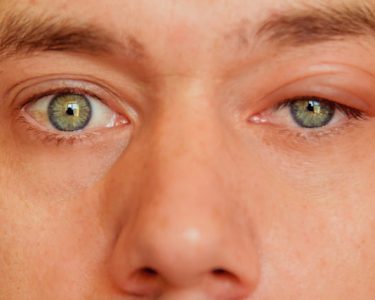Blepharitis is a common condition that causes inflammation of the eyelids, leading to redness, irritation, and crusty deposits near the base of the eyelashes. Proper eyelid hygiene is essential to manage this condition effectively. You how to clean eyelids blepharitis safely and efficiently, ensuring relief and improved eye health.
What is Blepharitis?
Blepharitis is an inflammation of the eyelids, often affecting the area where the eyelashes grow. It is a common eye condition that can cause irritation, redness, and swelling of the eyelid edges. While it is usually not a serious condition, it can lead to discomfort and, if left untreated, may result in other complications such as eyelash loss or infection.
Related Articles: 10 Natural Treatment for Blepharitis
Causes of Blepharitis:
Blepharitis can be caused by a variety of factors, including:
- Bacterial infection: The most common cause is a bacterial infection, particularly Staphylococcus aureus.
- Seborrheic dermatitis: This skin condition, which causes dandruff, can affect the eyelids and lead to inflammation.
- Rosacea: A skin condition that often affects the face, rosacea can also contribute to blepharitis.
- Allergies: Allergies to cosmetics, contact lens solutions, or environmental factors can irritate the eyelids.
- Meibomian gland dysfunction: Blocked or malfunctioning oil glands in the eyelids can lead to dry eyes and inflammation.
Symptoms of Blepharitis:
- Red, swollen eyelids
- Itchy or burning sensation in the eyes
- Crusty eyelid edges, especially upon waking up
- Watery eyes
- Sensitivity to light
- Gritty or foreign body sensation in the eyes
- Eyelash loss or misdirected eyelashes
How to Clean Eyelids Blepharitis
Blepharitis is an inflammation of the eyelids that can cause redness, irritation, and crusting around the eyes. One of the most effective ways to manage this condition is through proper eyelid hygiene. Here’s how to clean your eyelids if you have blepharitis:
Related Articles: How to Cure Blepharitis Fast and Naturally with Herbal Remedies
Step-by-Step Guide: How to Clean Eyelids Blepharitis
Step 1: Wash Your Hands
Before touching your eyes, wash your hands thoroughly with soap and water. This reduces the risk of introducing additional bacteria to the sensitive eye area.
Related Articles: Natural Remedies for Blepharitis Affecting the Eyelids
Step 2: Prepare the Cleaning Solution
You can use one of the following options:
- Warm Water and Baby Shampoo: Mix a few drops of baby shampoo in warm water.
- Commercial Eyelid Cleansers: These are specially formulated for sensitive eyes and available at pharmacies.
- Saline Solution: A mild saline solution can also help clean the eyelids.
Step 3: Apply a Warm Compress
Place a clean, warm compress (a soft cloth soaked in warm water) over your closed eyelids for 5–10 minutes. The heat helps loosen crusts and unclogs oil glands, making cleaning easier.
Step 4: Gently Clean the Eyelids
- Soak a cotton pad, swab, or clean washcloth in the prepared solution.
- Close your eyes and gently wipe along the lash line and eyelid margins.
- If there are crusts or debris, wipe away carefully without scrubbing.
- Repeat for the other eye, using a clean cotton pad or swab to avoid cross-contamination.
Step 5: Rinse and Pat Dry
Rinse your eyelids with lukewarm water to remove any remaining solution. Gently pat your eyes dry with a clean towel.
Related Articles: What is the Latest Treatment for Blepharitis?
Step 6: Follow with Medication (If Prescribed)
If your doctor has prescribed eye drops or ointments, apply them after cleaning your eyelids for maximum effectiveness.
Benefits of Clean Eyelids Blepharitis
Cleaning your eyelids regularly, especially for those dealing with blepharitis, offers several significant benefits:
- Reduces Inflammation: Blepharitis causes inflammation of the eyelid margins, leading to redness, swelling, and irritation. Cleaning the eyelids helps remove debris, bacteria, and oil buildup, reducing the chances of further irritation and inflammation.
- Prevents Infection: Regular eyelid cleaning helps remove harmful bacteria and prevents infections, which are common in blepharitis due to clogged glands. By maintaining a clean eyelid area, you can lower the risk of developing more serious eye infections like styes or conjunctivitis.
- Improves Eyelash Health: Blepharitis can cause the eyelashes to become crusted and matted, leading to discomfort. Cleaning the eyelids helps keep the eyelashes free from crusts and improves their overall health, making them look fuller and more vibrant.
- Reduces Dryness and Discomfort: Many people with blepharitis experience dryness, itchiness, and a gritty feeling in their eyes. Cleaning the eyelids can help alleviate these symptoms by removing excess oil and debris, restoring comfort and moisture to the eyes.
- Enhances Eye Comfort: When the eyelids and lashes are clean, they can function better, reducing the risk of eye irritation, discomfort, and tearing. This can lead to more comfort throughout the day, especially for those who wear contact lenses or have sensitive eyes.
- Improves Vision: In some cases, the buildup of oils and debris on the eyelid can affect the quality of the tear film, leading to blurry vision. By regularly cleaning the eyelids, you can promote better tear distribution and enhance overall vision clarity.
- Promotes Healthy Meibomian Glands: The meibomian glands, which help produce the oily layer of the tear film, can become blocked in individuals with blepharitis. Regular eyelid hygiene helps prevent these glands from becoming clogged, improving tear production and preventing dry eye symptoms.
Related Articles: Blepharitis Alternative Treatments: The Ultimate Guide for Clearer Eyes
Tips for Maintaining Good Eyelid Hygiene
- Clean your eyelids twice daily during active flare-ups and once daily for maintenance.
- Avoid using makeup on your eyes until the condition improves.
- Replace eye makeup products regularly to prevent bacterial contamination.
- Consult an eye care professional if symptoms persist or worsen despite regular cleaning.
When to See a Doctor
If you experience severe discomfort, vision changes, or swelling that doesn’t improve, consult an eye specialist. Blepharitis can sometimes lead to complications such as styes, chalazions, or corneal irritation.
By following this step-by-step guide on how to clean eyelids blepharitis, you can manage the condition effectively and maintain healthy eyelids. Consistency is key to achieving relief and preventing future episodes.




